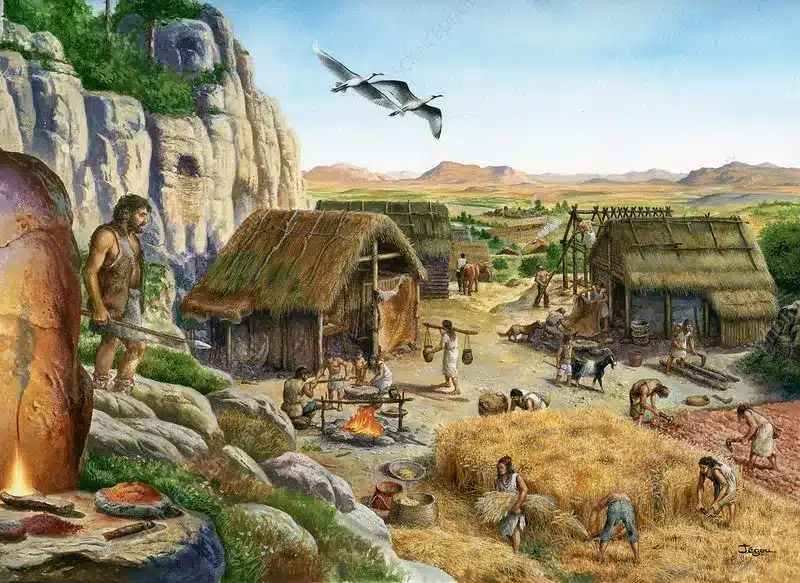About Neolithic Period
- The Neolithic Period, also called the New Stone Age, is the final stage of cultural evolution or technological development among prehistoric humans.
- The term Neolithic is most frequently used in connection with agriculture, which is the time when cereal cultivation and animal domestication were introduced.
- It is characterized by the beginning of a settled human lifestyle.
- The Neolithic stage of development was attained during the Holocene Epoch (the last 11,700 years of Earth’s history).
- The starting point of the Neolithic is generally thought to have occurred sometime around 10,000 BCE.
- The Neolithic followed the Paleolithic Period, or the age of chipped-stone tools, and preceded the Bronze Age, or the early period of metal tools.
- The Neolithic Revolution started in the Fertile Crescent, a region of the Middle East, where humans first took up farming.
- Features of the Neolithic Age:
- It was characterized by stone tools shaped by polishing or grinding, dependence on domesticated plants or animals, settlement in permanent villages, and the appearance of such crafts as pottery and weaving.
- The houses were built of mud and reed in rectangular or circular shapes.
- Alcohol was first produced during this period, and architecture, as well as its interior and exterior decoration, first appeared.
- Status objects like elaborate pottery and carved jades were placed in tombs during the Neolithic period. This practice suggests two things: Neolithic people’s belief in the afterlife and the emergence of social classes. Only important and wealthy individuals had the privilege of being buried with these precious objects
- End of the Neolithic Age:
- Towards the end of the Neolithic era, copper metallurgy is introduced, which marks a transition period to the Bronze Age, sometimes referred to as the Chalcolithic or Eneolithic Era.
- In time, bronze became the primary material for tools and weapons, and a good part of the stone technology became obsolete, signalling the end of the Neolithic and thus of the Stone Age.
- Some of the important Neolithic sites in India include Burzahom in Kashmir, Chiron in Bihar and Uttar in Andhra Pradesh, and Edakkal caves in Kerala.
Q1) What is the Paleolithic Period?
The Paleolithic Age, also known as the Stone Age, is a prehistoric period that spanned from about 2.6 million years ago to around 10,000 BCE (Before Common Era). It is the earliest and longest period of human history, characterized by the use of stone tools by early human beings.
Source: Tamil Nadu: Child burial site dating back to neolithic age unearthed in Chengalpattu
Last updated on June, 2025
→ UPSC Notification 2025 was released on 22nd January 2025.
→ UPSC Prelims Result 2025 is out now for the CSE held on 25 May 2025.
→ UPSC Prelims Question Paper 2025 and Unofficial Prelims Answer Key 2025 are available now.
→ UPSC Calendar 2026 is released on 15th May, 2025.
→ The UPSC Vacancy 2025 were released 1129, out of which 979 were for UPSC CSE and remaining 150 are for UPSC IFoS.
→ UPSC Mains 2025 will be conducted on 22nd August 2025.
→ UPSC Prelims 2026 will be conducted on 24th May, 2026 & UPSC Mains 2026 will be conducted on 21st August 2026.
→ The UPSC Selection Process is of 3 stages-Prelims, Mains and Interview.
→ UPSC Result 2024 is released with latest UPSC Marksheet 2024. Check Now!
→ UPSC Toppers List 2024 is released now. Shakti Dubey is UPSC AIR 1 2024 Topper.
→ Also check Best IAS Coaching in Delhi
























